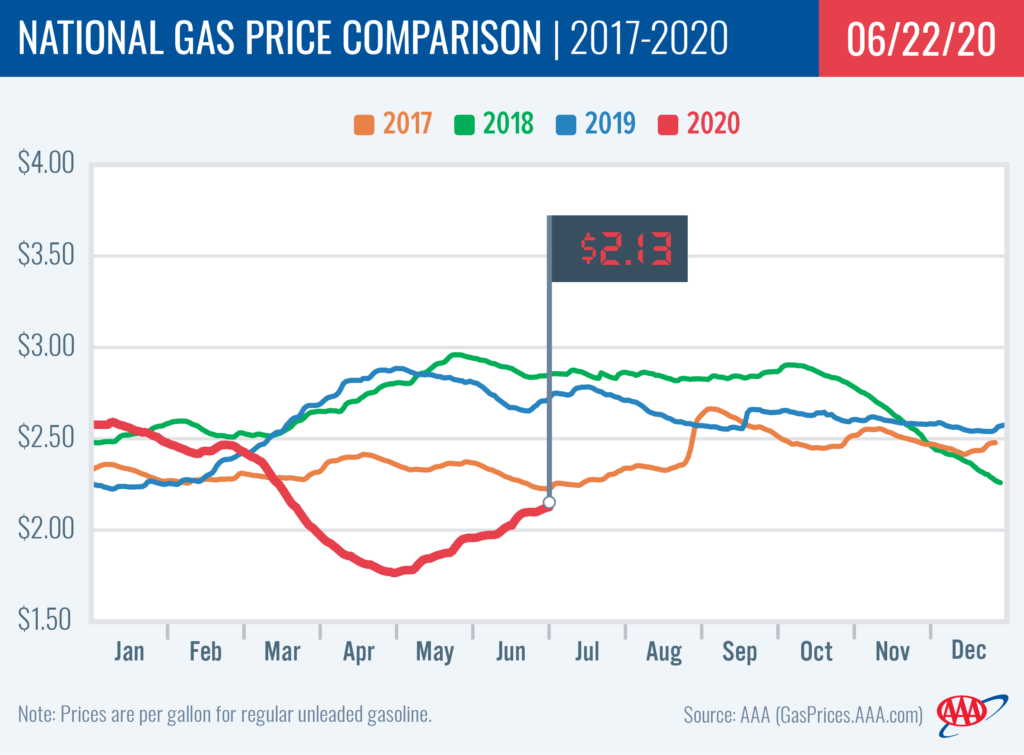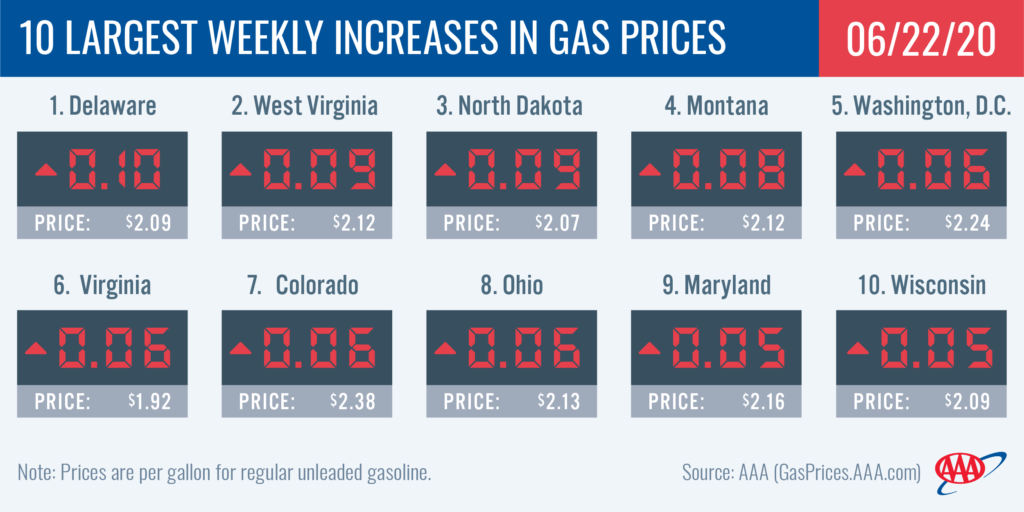The rate at which gas prices are increasing across the country is slowing. Thirty states only saw an increase of a penny or two, causing the national average to push more expensive by three cents to $2.13 since last Monday.
The slower rate can be tied to demand. Measuring at 7.87 million b/d, gasoline demand saw a small week-over-week decline and continues to be significantly lower (21%) compared to this week last year.
“Demand levels are likely to ebb and flow in the coming weeks as people continue to be cautious about travel,” said Jeanette Casselano, AAA spokesperson. As a result, pump prices will likely continue to increase, but at a slower rate through the end of the month.
Today’s national average is 19 cents more expensive than a month ago, but remains significantly cheaper – 53 cents – than a year ago.

Quick Stats
- The nation’s top 10 largest weekly increases: Delaware (+10 cents), West Virginia (+9 cents), North Dakota (+9 cents), Montana (+8 cents), Washington, D.C. (+6 cents), Virginia (+6 cents), Colorado (+6 cents), Ohio (+6 cents), Maryland (+5 cents) and Wisconsin (+5 cents).
- The nation’s top 10 least expensive markets: Mississippi ($1.76), Louisiana ($1.79), Alabama ($1.83), Arkansas ($1.83), Texas ($1.83), Oklahoma ($1.84), Missouri ($1.85), South Carolina ($1.86), Tennessee ($1.89) and Kansas ($1.92).

Rockies
Montana (+8 cents) and Colorado (+6 cents) had the largest jumps in the region, which also landed both states on the country’s top 10 list again this week. The Rockies region’s three other state averages only saw changes of just a few cents, including a decline: Utah (-1 cent), Idaho (+2 cents) and Wyoming (+3 cents).
At the start of the week, state averages are: Colorado ($2.38), Idaho ($2.32), Utah ($2.26), Montana ($2.12) and Wyoming ($2.07).
Regional gasoline stocks dipped by a small 340,000 bbl to drop total levels to 7.3 million bbl. The EIA reports regional refinery utilization saw a second week of significant increase, jumping up to 82%. That is a 13% increase since the week ending May 22. The increase in utilization will likely yield higher stocks and in turn help to minimize pump price increases.
West Coast
Pump prices in the West Coast region mostly increased last week, and prices likely are poised for more increases this week. Nevada (+5 cents) saw largest increase in the region, while Hawaii (-2 cents) saw the only decline. Hawaii ($3.16) and California ($3.04) remain the most expensive markets in the country. Washington ($2.68), Nevada ($2.58), Oregon ($2.57), Alaska ($2.43) and Arizona ($2.29) follow.
According to EIA’s latest weekly report, total gas stocks in the region increased slightly from 30.1 million bbl to 30.2 million bbl last week. Increasing stocks, alongside increasing demand, may help to slow pump price increases this week in the region.
South and Southeast
State gas price averages in the South and Southeast region only increased a few pennies on the week. While Florida ($2.02) remains the only state in the region with an average greater than $2 per gallon, New Mexico ($1.98) and Georgia ($1.92) are likely the next states to break this threshold. At $1.76, Mississippi carries the cheapest average in the region and country.
After a few weeks of stock builds, the EIA reports the South and Southeast region saw a draw of just under 1 million bbl. Total stocks drop down to 90.8 million bbl, which is still a significant 10 million bbl surplus. The rate at which gas prices increase has started to slow in the region, which is likely to continue to be the trend for the rest of the month, although a spike ahead of the July 4 holiday weekend can’t be ruled out.

Mid-Atlantic and Northeast
Weekly increases were minimal – one to three cents – for the majority of the region with the exception of these three states: Delaware (+10 cents), West Virginia (+9 cents) and Maryland (+5 cents).
For motorists filling up within the Mid-Atlantic and Northeast region, they can expect to find state averages fluctuating from a high of $2.36 in Pennsylvania to a low of $1.92 in Virginia.
The prior week’s nearly 1 million bbl build was wiped out with a draw of 1 million bbl according to EIA data for the week ending June 12. Regional gasoline stocks sit at 74.1 million bbl as refinery utilization dipped just under 50%. AAA expects the region to see gas prices continue to increase in the weeks ahead, especially as more Americans feel comfortable traveling.
Great Lakes and Central States
As forecasted, the bulk of the region saw smaller increases on the week at three cents or less, although two Great Lakes and Central states landed on the top 10 list for largest weekly jumps: North Dakota (+9 cents) and Ohio (+6 cents).
The region was just one of two to see stocks build. According to the EIA, stocks increased by 455,000 bbl to push total levels to 54.5 million bbl. On trend with the rest of the country, gas prices in the region will continue to increase, though at a slower rate, in the week ahead.
Oil Market Dynamics
At the end of Friday’s formal trading session, WTI increased by 91 cents to settle at $39.75 per barrel. Domestic crude prices increased at the end of last week amid increased market optimism regarding trade relations between the U.S. and China and greater focus on compliance with the production reduction agreement between the Organization of the Petroleum Exporting Countries (OPEC) and its partners, including Russia, which has worked to cut global crude production by 9.7 million b/d since May 1, 2020. It remains unclear if OPEC’s agreement will extend into August; it is currently set to expire at the end of July. For this week, crude prices will likely remain volatile as the market assesses if global crude demand will decrease due to a spike in new coronavirus infections worldwide.
Motorists can find current gas prices along their route with the free AAA Mobile app for iPhone, iPad and Android. The app can also be used to map a route, find discounts, book a hotel and access AAA roadside assistance. Learn more at AAA.com/mobile.
